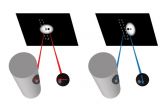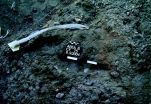(Press-News.org) Prosthetics with a realistic sense of touch. Bridges that detect and repair their own damage. Vehicles with camouflaging capabilities.
Advances in materials science, distributed algorithms and manufacturing processes are bringing all of these things closer to reality every day, says a review published today in the journal Science by Nikolaus Correll, assistant professor of computer science, and research assistant Michael McEvoy, both of the University of Colorado Boulder.
The "robotic materials" being developed by Correll Lab and others are often inspired by nature, Correll said.
"We looked at organisms like the cuttlefish, which change their appearance depending on their environment, and the banyan tree, which grows above-ground roots to support the increasing weight of the trunk," Correll said. "We asked what it would take to engineer such systems."
Robotic materials require tight integration between sensing, computation and actually changing the materials properties of the underlying material. While materials can already be programmed to change some of their properties in response to specific stimuli, robotic materials can sense stimuli and determine how to respond on their own.
Correll and McEvoy use the example of artificial skin equipped with microphones that would analyze the sounds of a texture rubbing the skin and route information back to the central computer only when important events occurred.
"The human sensory system automatically filters out things like the feeling of clothing rubbing on the skin," Correll said. "An artificial skin with possibly thousands of sensors could do the same thing, and only report to a central 'brain' if it touches something new."
While all of these materials are possible, the authors caution that manufacturing techniques remain a challenge.
"Right now, we're able to make these things in the lab on a much larger scale, but we can't scale them down," Correll said. "The same is true for nano- and microscale manufacturing, which can't be scaled up to things like a building façade."
The field also faces an education gap, the authors say. Developing robotic materials requires interdisciplinary knowledge that currently isn't provided by materials science, computer science or robotics curricula alone.
At CU-Boulder, Correll is addressing that gap with a freshman-level engineering projects class called "Materials That Think."
"We expose engineering students to both materials and computing, no matter what their background is," he said.
In the long run, Correll believes robotic materials will be used in everyday items, like shoe insoles that could sense pressure and adapt their stiffness to adjust to walking or running.
"While we can imagine such a material consisting of little patches that each include an actuator, sensor and little computer, we have a hard time imagining such a complex piece of technology could ever be affordable," he said. "I think the last 10 years of advances in smartphones have demonstrated the opposite."
INFORMATION:
Biologists at the University of California, San Diego have developed a new method for generating mutations in both copies of a gene in a single generation that could rapidly accelerate genetic research on diverse species and provide scientists with a powerful new tool to control insect borne diseases such as malaria as well as animal and plant pests.
Their achievement was published today in an advance online paper in the journal Science. It was accomplished by two biologists at UC San Diego working on the fruit fly Drosophila melanogaster who employed a new genomic technology ...
Berkeley -- Scientists at the University of California, Berkeley, have identified a new molecular pathway critical to aging, and confirmed that the process can be manipulated to help make old blood like new again.
The researchers found that blood stem cells' ability to repair damage caused by inappropriate protein folding in the mitochondria, a cell's energy station, is critical to their survival and regenerative capacity.
The discovery, to be published in the March 20 issue of the journal Science, has implications for research on reversing the signs of aging, a process ...
Without better local management, the world's most iconic ecosystems are at risk of collapse under climate change, say researchers in a study published in the journal Science.
The international team of researchers say protecting places of global environmental importance such as the Great Barrier Reef and the Amazon rainforest from climate change requires reducing the other pressures they face, for example overfishing, fertilizer pollution or land clearing.
The researchers warn that localised issues, such as declining water quality from nutrient pollution or deforestation, ...
The 2014 chemistry Nobel Prize recognized important microscopy research that enabled greatly improved spatial resolution. This innovation, resulting in nanometer resolution, was made possible by making the source (the emitter) of the illumination quite small and by moving it quite close to the object being imaged. One problem with this approach is that in such proximity, the emitter and object can interact with each other, blurring the resulting image. Now, a new JQI study has shown how to sharpen nanoscale microscopy (nanoscopy) even more by better locating the exact ...
Sifting through the center of the Milky Way galaxy, astronomers have made the first direct observations - using an infrared telescope aboard a modified Boeing 747 - of cosmic building-block dust resulting from an ancient supernova.
"Dust itself is very important because it's the stuff that forms stars and planets, like the sun and Earth, respectively, so to know where it comes from is an important question," said lead author Ryan Lau, Cornell postdoctoral associate for astronomy, in research published March 19 in Science Express. "Our work strongly reinforces the theory ...
Researchers from Banner Alzheimer's Institute (BAI) have developed a new brain image analysis method to better track the progression of beta-amyloid plaque deposition, a characteristic brain abnormality in Alzheimer's disease, according to a study published in the March issue of the Journal of Nuclear Medicine. Investigators also believe this new approach may make it easier to evaluate investigational anti-amyloid treatments in clinical trials.
During the last decade, researchers have been using positron emission topography (PET) to assess amyloid plaque deposition in ...
A psychology study from The University of Texas at Austin sheds new light on today's standards of beauty, attributing modern men's preferences for women with a curvy backside to prehistoric influences.
The study, published online in Evolution and Human Behavior, investigated men's mate preference for women with a "theoretically optimal angle of lumbar curvature," a 45.5 degree curve from back to buttocks allowing ancestral women to better support, provide for, and carry out multiple pregnancies.
"What's fascinating about this research is that it is yet another scientific ...
WASHINGTON, March 19, 2015 -- It's a simple claim made on thousands of personal care products for adults and kids: hypoallergenic. But what does that actually mean? Turns out, it can mean whatever manufacturers want it to mean, and that can leave you feeling itchy. Speaking of Chemistry is back this week with Sophia Cai explaining why "hypoallergenic" isn't really a thing. Check it out here: http://youtu.be/lXh8bnqMOZs.
Speaking of Chemistry is a production of Chemical & Engineering News, a weekly magazine of the American Chemical Society. The program features fascinating, ...
The Canadian research community on high-temperature superconductivity continues to lead this exciting scientific field with groundbreaking results coming hot on the heels of big theoretical questions.
The latest breakthrough, which will be published March 20 in Science, answers a key question on the microscopic electronic structure of cuprate superconductors, the most celebrated material family in our quest for true room-temperature superconductivity.
This result is the product of a longstanding close collaboration between the University of British Columbia Quantum ...
Some 2.5 million years ago, early humans survived on a paltry diet of plants. As the human brain expanded, however, it required more substantial nourishment - namely fat and meat - to sustain it. This drove prehistoric man, who lacked the requisite claws and sharp teeth of carnivores, to develop the skills and tools necessary to hunt animals and butcher fat and meat from large carcasses.
Among elephant remains some 500,000 years old at a Lower Paleolithic site in Revadim, Israel, Prof. Ran Barkai and his graduate students Natasha Solodenko and Andrea Zupanchich of Tel ...



